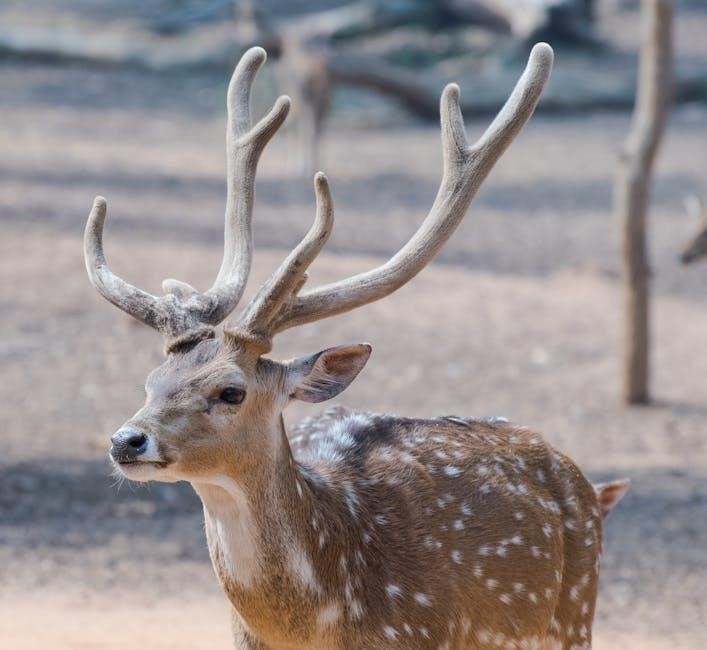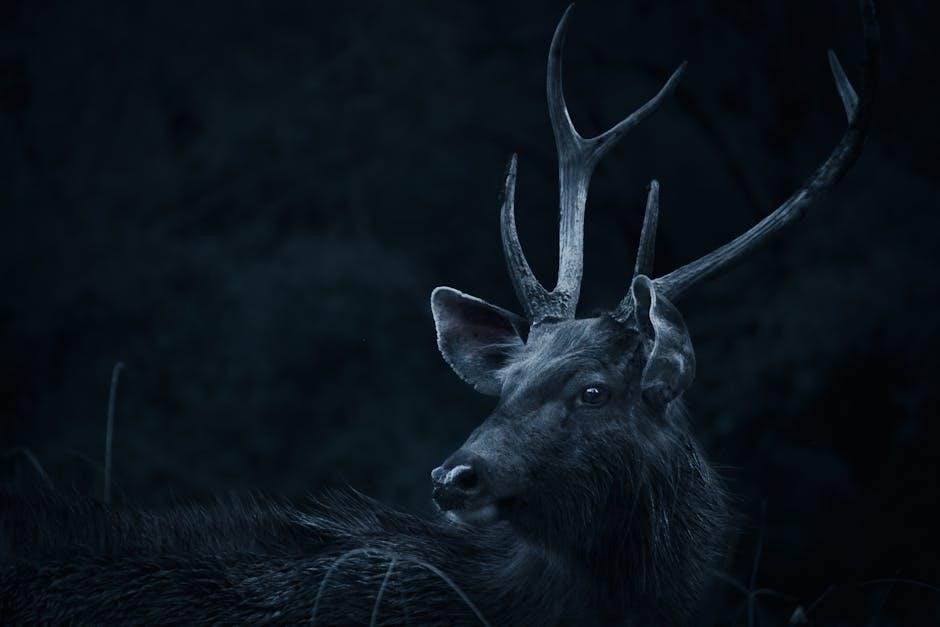The Buck Alaskan Guide is a highly skilled professional, expert in wilderness navigation, survival, and wildlife knowledge, ensuring safe and educational outdoor experiences in Alaska’s rugged terrain.

1.1 Overview of the Role and Importance
The Buck Alaskan Guide plays a pivotal role in ensuring safe and enriching outdoor experiences in Alaska’s vast wilderness. Their expertise in navigation, survival, and wildlife knowledge is essential for guiding clients through challenging terrain. These professionals are indispensable for adventurers seeking to explore Alaska’s pristine landscapes while maintaining safety and environmental awareness.
Their role extends beyond guiding; they serve as educators, sharing insights into local ecosystems and promoting responsible tourism. By fostering a deeper connection between clients and nature, Buck Alaskan Guides contribute significantly to conservation efforts and the preservation of Alaska’s unique wilderness heritage.
1.2 Historical Background of Alaskan Guides
Alaskan guides have a rich history rooted in indigenous traditions and wilderness expertise. Native peoples initially served as guides, sharing their knowledge of the land and survival skills with early explorers. As Alaska’s popularity grew, professional guiding evolved, blending traditional methods with modern techniques. Early guides played a crucial role in exploration and hunting expeditions, laying the foundation for today’s professional guiding industry.

Key Skills and Qualifications
Buck Alaskan Guides must possess physical stamina, wilderness first aid knowledge, navigation expertise, and deep environmental awareness to lead safe and successful expeditions in Alaska’s challenging landscapes.
2.1 Physical and Mental Requirements
Buck Alaskan Guides must possess exceptional physical endurance, strength, and agility to navigate rugged terrains. They need mental resilience to handle stress, make quick decisions, and remain focused in extreme conditions. The ability to work in harsh weather, carry heavy gear, and maintain composure during emergencies is crucial. Both physical and mental toughness are essential for ensuring safety and success in Alaska’s unforgiving wilderness environments.
2.2 Necessary Certifications and Training
Buck Alaskan Guides must obtain specific certifications to ensure competence in wilderness environments. Required certifications include CPR/First Aid, Wilderness First Responder (WFR), and state-issued guiding licenses. Additional training in wildlife management and environmental education is often necessary. These qualifications ensure guides can safely navigate and manage client experiences in Alaska’s challenging terrain, providing both safety and educational value during expeditions.

Wildlife and Habitat Knowledge
Understanding Alaska’s diverse wildlife ecosystems is crucial for guides, enabling them to identify species, track animals, and navigate habitats effectively while ensuring safe client interactions.
3.1 Understanding Local Ecosystems
Alaskan ecosystems are dynamic and interconnected, comprising vast wilderness areas, including tundras, forests, and wetlands. Guides must recognize how these habitats support diverse flora and fauna, ensuring sustainable coexistence. Understanding local ecosystems allows guides to predict animal behavior, identify food sources, and navigate terrain effectively, while also recognizing signs of environmental change or stress, which is critical for maintaining balance and safety during expeditions.
3.2 Identifying and Tracking Wildlife

Identifying and tracking wildlife is a cornerstone skill for Buck Alaskan Guides. They must recognize animal species, such as bears, moose, and wolves, by their footprints, scat, and behavioral signs. Understanding habitat preferences and seasonal movements allows guides to locate wildlife effectively. This expertise ensures safe and rewarding encounters, while also enabling guides to predict potential threats and maintain client safety during wilderness expeditions in Alaska’s vast and unpredictable environments.
Survival and Safety Techniques
Buck Alaskan Guides must master survival skills like navigation, shelter-building, and emergency preparedness. They expertly handle harsh weather, ensuring client safety in Alaska’s unforgiving wilderness environments.
4.1 Navigation and Emergency Preparedness
Buck Alaskan Guides excel in navigation using maps, compasses, and GPS. They are trained in emergency preparedness, including knot-tying, first aid, and communication tools like satellite phones. Survival instincts are honed to handle crises such as sudden weather shifts or medical emergencies. Guides also know how to locate natural shelters and start fires, ensuring safety in remote, disconnected areas. This expertise is vital for traversing Alaska’s vast, unpredictable wilderness.
4.2 Dealing with Extreme Weather Conditions
Buck Alaskan Guides are adept at managing extreme weather, from blizzards to subzero temperatures. They ensure client safety by predicting weather shifts and employing gear like insulated clothing and snowshoes. Hypothermia prevention is a priority, with guides trained to recognize signs and act swiftly. Avalanche safety protocols are also crucial, ensuring safe traversal of snowy terrains. Their expertise allows seamless adaptation to Alaska’s harsh, unpredictable climate.
Legal and Ethical Considerations
Buck Alaskan Guides must adhere to state and federal regulations, ensuring sustainable practices and ethical treatment of wildlife. They uphold environmental conservation and responsible tourism standards.
5.1 Hunting and Fishing Regulations
Buck Alaskan Guides must comply with Alaska’s strict hunting and fishing regulations, ensuring sustainable practices. They obtain necessary permits, adhere to bag limits, and respect seasonal restrictions. Guides are well-versed in state and federal laws to protect wildlife populations and habitats. This includes proper gear usage, catch-and-release practices, and reporting requirements. Compliance ensures ethical outdoor activities while preserving Alaska’s natural resources for future generations.
5.2 Environmental Conservation Practices
Buck Alaskan Guides prioritize environmental conservation by minimizing their ecological footprint. They practice Leave No Trace principles, ensuring minimal impact on Alaska’s pristine wilderness. Guides promote sustainable tourism by educating clients on waste reduction, proper disposal, and respecting wildlife habitats. They also support local conservation efforts and adhere to eco-friendly guidelines, preserving Alaska’s natural beauty for future generations while fostering a deeper appreciation for its unique ecosystems.
Tools and Equipment
Buck Alaskan Guides rely on durable gear, including rifles, camping equipment, and navigation tools. They use reliable equipment tailored for harsh environments, ensuring safety and efficiency in expeditions.
6.1 Essential Gear for Guiding
A Buck Alaskan Guide relies on sturdy, weather-resistant gear, including high-caliber rifles, durable camping equipment, and precise navigation tools. They also carry first aid kits, emergency shelters, and communication devices. Waterproof clothing, insulated sleeping bags, and reliable backpacks are crucial for enduring Alaska’s harsh conditions. Additionally, portable water purification systems and multi-tools ensure preparedness for any situation, making their gear essential for both safety and efficiency in the wilderness.
6.2 Maintenance and Use of Equipment
Proper maintenance of gear is critical for a Buck Alaskan Guide. This includes meticulous cleaning, lubrication of moving parts, and regular inspections to ensure functionality. Guides are trained to use equipment safely and efficiently, adhering to manufacturer guidelines. Hands-on training ensures proficiency with tools like rifles, navigation devices, and camping gear. Rigorous cleaning schedules and storage practices prolong equipment lifespan, while adherence to safety protocols guarantees reliability in extreme conditions.

Client Management and Communication
Buck Alaskan Guides excel in fostering strong client relationships through clear communication, ensuring safety, and adapting to client needs, creating a memorable and enriching outdoor experience.
7.1 Building Client Relationships
Buck Alaskan Guides prioritize trust and rapport with clients, ensuring clear communication and understanding of expectations. They tailor experiences to individual needs, fostering a connection that enhances the adventure. By actively listening and adapting, guides create a personalized journey, ensuring safety and satisfaction. Strong relationships are built on mutual respect, reliability, and shared enthusiasm for Alaska’s wilderness, making each expedition memorable and enriching.
7.2 Effective Communication in the Field
Effective communication is crucial for Buck Alaskan Guides to ensure safety and seamless experiences. Clear, concise instructions and active listening are essential. Guides adapt their communication style to clients’ needs, using verbal and non-verbal cues. Regular check-ins and feedback ensure alignment and address concerns promptly. This approach fosters trust and ensures that every expedition is executed safely and efficiently, meeting client expectations in Alaska’s challenging environment.
Case Studies and Success Stories
Notable Buck Alaskan Guides have led successful expeditions, showcasing their expertise in navigating Alaska’s wilderness. Their stories highlight resilience, client satisfaction, and the true spirit of adventure.
8.1 Notable Alaskan Guides and Their Experiences
Renowned Buck Alaskan Guides have demonstrated exceptional leadership and expertise, navigating Alaska’s vast wilderness with precision and safety. Their experiences often involve overcoming extreme challenges, such as harsh weather and remote terrain, while ensuring client safety and memorable adventures. These guides exemplify the professionalism and dedication required to thrive in one of the world’s most unforgiving environments, leaving lasting impressions on those they lead.
8.2 Lessons Learned from Challenging Expeditions
Challenging expeditions have taught Buck Alaskan Guides invaluable lessons, emphasizing adaptability, thorough preparedness, and swift decision-making. They’ve learned to navigate unpredictable weather, manage client expectations, and handle emergencies effectively. These experiences highlight the importance of teamwork, clear communication, and maintaining composure under pressure, ensuring safer and more successful future ventures in Alaska’s unforgiving wilderness.

Future of Alaskan Guiding
The future of Alaskan guiding lies in embracing technology, adapting to climate change, and promoting sustainable tourism practices to preserve Alaska’s pristine wilderness for future generations.
9.1 Impact of Climate Change
Climate change is altering Alaska’s ecosystems, with melting ice, rising temperatures, and shifting wildlife patterns. Guides must adapt to these changes, ensuring safe navigation and ethical practices. Thawing permafrost and unpredictable weather demand innovative strategies, while habitat disruptions affect wildlife behavior. These challenges require guides to stay informed and flexible, balancing tradition with modern solutions to maintain sustainable and responsible guiding practices in a changing environment.
9.2 Technological Advancements in Guiding
Technological advancements are revolutionizing the Alaskan guiding profession. GPS navigation, satellite communication, and weather monitoring tools enhance safety and efficiency. Drones and thermal imaging aid in tracking wildlife, while apps provide real-time data on environmental conditions. These innovations improve decision-making, client safety, and the overall guiding experience, enabling guides to adapt to changing landscapes and deliver more informed, sustainable, and enjoyable expeditions in Alaska’s vast wilderness.
The Buck Alaskan Guide exemplifies exceptional skill, dedication, and passion for wilderness exploration, ensuring unforgettable adventures while preserving Alaska’s pristine beauty for future generations.
10.1 Final Thoughts on the Profession
The Buck Alaskan Guide profession represents a unique blend of wilderness expertise, physical endurance, and deep environmental connection. It demands adaptability, resilience, and a genuine passion for Alaska’s untamed landscapes. Guides play a crucial role in preserving the state’s natural beauty while educating clients about its ecosystems. The profession is both challenging and rewarding, offering unparalleled opportunities to connect with nature and inspire others through unforgettable experiences.
10.2 Encouragement for Aspiring Guides
For those passionate about Alaska’s wilderness, becoming a Buck Alaskan Guide offers a fulfilling career. It requires dedication, resilience, and a deep love for nature. Aspiring guides should embrace continuous learning, seek mentorship, and stay committed to safety and conservation. The rewards are immense, from exploring pristine landscapes to inspiring others. Pursue this path with determination, and you’ll find a lifetime of adventure and purpose in Alaska’s vast wilderness.